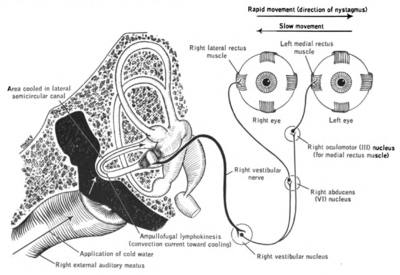Caloric reflex test
| Caloric reflex test, vestibulo-ocular reflex | |
|---|---|
| Medical diagnostics | |

Caloric test. Cold water introduced into right external meatus showing effects opposite to that produced by introduction of hot water. (Lawrence et al. 1960)
|
|
| ICD-9-CM | 95.44 |
| MedlinePlus | 003429 |
In medicine, the caloric reflex test (sometimes termed 'vestibular caloric stimulation') is a test of the vestibulo-ocular reflex that involves irrigating cold or warm water or air into the external auditory canal. This method was developed by Robert Bárány who won a Nobel prize in 1914 for this discovery.
It is commonly used by physicians, audiologists and other trained professionals to validate a diagnosis of asymmetric function in the peripheral vestibular system. Calorics are usually a subtest of the electronystagmography (ENG) battery of tests. It is one of several tests which can be used to test for brain stem death.
One novel use of this test has been to provide temporary pain relief from phantom limb pains in amputees and paraplegics. It can also induce a temporary remission of anosognosia, the visual and personal aspects of hemispatial neglect, hemianesthesia, and other consequences of right hemispheric damage.
Ice cold or warm water or air is irrigated into the external auditory canal, usually using a syringe. The temperature difference between the body and the injected water creates a convective current in the endolymph of the nearby horizontal semicircular canal. Hot and cold water produce currents in opposite directions and therefore a horizontal nystagmus in opposite directions. In patients with an intact brainstem:
Absent reactive eye movement suggests vestibular weakness of the horizontal semicircular canal of the side being stimulated.
...
Wikipedia
